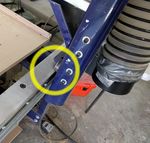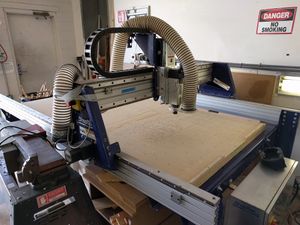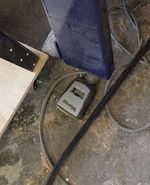Difference between revisions of "ShopBot"
(→Safety: Added photo link for x-axis crush danger) |
|||
| Line 10: | Line 10: | ||
* Do not leave the ShopBot running unattended. Hitting the space bar will pause a cut and allow it to be resumed. | * Do not leave the ShopBot running unattended. Hitting the space bar will pause a cut and allow it to be resumed. | ||
| − | * Beware of the tracks that the x-axis carriage travels on. Do not rest your hands on them. The carriage can move quickly and crush fingers. | + | * Beware of the tracks that the x-axis carriage travels on. Do not rest your hands on them. The carriage can move quickly and crush fingers. [[File:ShopBot_crush_danger.jpg|150px|Crush danger: keep fingers clear]] |
* Be sure your work is securely mounted on the table in all three dimensions (see yet-to-be-written section, below). | * Be sure your work is securely mounted on the table in all three dimensions (see yet-to-be-written section, below). | ||
* Use adequate tabs for any profile cuts. Although there's no one tab size that works for any project, bigger tabs are always safer. | * Use adequate tabs for any profile cuts. Although there's no one tab size that works for any project, bigger tabs are always safer. | ||
Revision as of 12:48, 27 September 2016
TinkerMill has a ShopBot PRS Alpha, a CNC router that can be used for cutting wood or plastic according to CAD designs. The usual workflow is to create a design in CAD or drawing software (such as Inkscape, CorelDraw, or Adobe Illustrator), load it into VCarve, which plans the cuts and outputs parts files, which are then loaded into the ShopBot software to execute on the machine.
Contents
Basics
The essentials of operating the ShopBot are below. They are here as a reference, and not a substitute for taking the ShopBot class.
Safety
The typical and obvious woodshop safety precautions should also be used with the ShopBot: always wear safety glasses; keep your hands away; do not wear baggy sleeves, jewelry, etc. that might get caught. More specific to the ShopBot:
- Do not leave the ShopBot running unattended. Hitting the space bar will pause a cut and allow it to be resumed.
- Beware of the tracks that the x-axis carriage travels on. Do not rest your hands on them. The carriage can move quickly and crush fingers.

- Be sure your work is securely mounted on the table in all three dimensions (see yet-to-be-written section, below).
- Use adequate tabs for any profile cuts. Although there's no one tab size that works for any project, bigger tabs are always safer.
Starting the ShopBot
Make sure the ShopBot is plugged in, since it is currently sharing a 3-phase outlet with the table saw. (If the table saw has a green light on the RFID box, hit the red button to log out the previous user before unplugging it.)
Open the lockbox using the code provided in the ShopBot class, and unlock the power switch. It's recommended that you return the key and lock the lockbox, and just leave the padlock open while you are using the ShopBot.
On the computer, start the ShopBot 3 program. Make sure all the emergency stops are not pushed. When the software starts up, you will need to push the blue reset button.
Securing your work
Changing bits
Zeroing
Loading and running cuts
VCarve and planning ShopBot cuts
So you have a beautiful drawing of your part, and you have a ShopBot, which can move a tool around in 3-dimensional space. How can you put the two together to cut your part out? The task of planning toolpaths--where the bit is going to move, and at what speed--is usually accomplished using VCarve. A trial edition is sufficient for planning cuts, and then you can save your work and load it on the full version at TinkerMill to calculate and export toolpaths, which are then loaded into the ShopBot software to be executed. TinkerMill has a MakerSpace license for VCarve Pro, which allows members to activate a home installation of VCarve as clients. The activation key is provided to those taking the ShopBot class.

